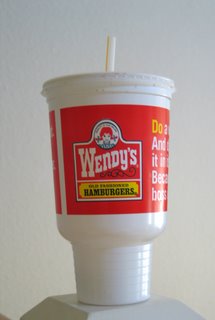 While in college, I worked at the 222 Espresso Bar, one of those kitschy and lively places populated by individuals that are slightly on the other side of the fringes of normal society—artists, poets, general weirdoes and those who live their lives strictly adhering to an –ism—while the walls dripped with local expressionistic art that borderlines on offensive if you look at it just so. We served mostly hot drinks with the polar exception of this ice sludge I hated to make for people, but everything we served was a good value for what you got. The cappuccinos were in big mugs and the coffee was bottomless (and if you were my friend or family, most times, I didn’t care if you paid or not).
While in college, I worked at the 222 Espresso Bar, one of those kitschy and lively places populated by individuals that are slightly on the other side of the fringes of normal society—artists, poets, general weirdoes and those who live their lives strictly adhering to an –ism—while the walls dripped with local expressionistic art that borderlines on offensive if you look at it just so. We served mostly hot drinks with the polar exception of this ice sludge I hated to make for people, but everything we served was a good value for what you got. The cappuccinos were in big mugs and the coffee was bottomless (and if you were my friend or family, most times, I didn’t care if you paid or not).In addition to never drinking the coffee, et al, I don’t drink hot drinks in general. Kara enjoys a cup of tea when the weather turns, but I could never get into it. I like them cold. When we patron restaurants, I expect my Diet Coke to have ice in it, lots of ice; it seems complete and natural, but at home, I rarely add ice to anything I drink, unless the two-liter bottle was just pulled from the grocery bag. Then I start with a big cup of ice, but the funny thing about regular Coke or Pepsi is that it can never be cold enough. I could just pull a glass of Pepsi out of a cryogenic freezer powered with liquid nitrogen and it would still have a “warm” flavor to it, which is one of the reasons I enjoy Diet Coke, as it is lighter in flavor, not syrupy, giving it a refreshing taste.
One of the pleasures of fast food—despite the heart-squeezing cholesterol levels and the rampant cruelty to animals, not to mention the use of illegal aliens for a workforce—is the fact that they serve fountain drinks (if you haven’t read it, read this and you’ll swear off fast food forever). It goes without saying that certain levels of cola syrup and pressurized carbon dioxide mixed together at just the right amount is far superior than anything you’ll find in an aluminum can or plastic bottle from the store.
When I was a bus boy at a Mexican restaurant during the summer before my senior year in 1990, I lived on half Diet Coke and half Dr. Pepper, maybe a gallon of it a shift. I don’t think I slept all summer.
Maybe it’s the plastic straw or the waxy paper cup that makes it a better drink, or perhaps it’s the fact that I can press down those little plastic tabs that says I’m drinking “other,” but it might be the ice that helps with the flavoring, a psychological effect that makes me think I’m getting a better drink. More than likely, the ice gives the CO² more surface area to form bubbles on, therefore keeping it carbonated for longer, and I think the fact that I’m paying for a service, something that someone else made and delivered to my table or car window makes it taste better (How is it that a sandwich tastes better when your wife makes it rather than when you make it? Is it because you’re experiencing all of the sandwich elements in their original and separate forms instead of amalgamated into the final product and mayonnaise by itself smells like cat vomit?).
However, from this day forth, when I do eat at fast food, I will request “no ice” in my drink, regardless of the situation, and this is for two distinct reasons.
The first is something I discovered while nosing around the Internet, looking for interesting facts about ice as it pertains to soda and fast food compaines. According to a report from ABC News a couple of months ago, for a science project, a 12-year-old compared the bacteria levels in ice samples from five restaurants in South Florida with toilet water samples taken from the same restaurants. I’m sure you can guess the results, but Jasmine Roberts of Benito Middle School in Tampa, discovered that the bacteria levels in the ice was higher, much higher, than the toilet water. It makes sense if you really think about it. How many of us clean the plumbing of our ice makers with chlorine as opposed to how often our toilets get cleaned (especially if you have some every-flush-type cleaner hiding in the tank that dumps bacteria-killing chemicals every time you flush)? And how often do they clean out the ice buckets, trays, makers, and storage bins? Remember, I worked at a restaurant, and the answer is hardly ever.
The second reason is a bit more miserly, more frugal and more of the need in today’s commercial environment to get a bigger bang for my buck. A couple of weeks ago, after a visit at Grandma and Grandpa’s house, the family brood swung by the drive-thru at Wendy’s for a hopefully nutritious meal of cheeseburgers, French fries and a Diet Coke… of course, for Natalie, she got chicken nuggets, orange slices and white milk. The cheeseburgers and fries were fine, I won’t starve for another day, but when I polished off my Diet Coke in less time than it took me to finish half a hamburger, I thought something was amiss. Sure, I drink a lot of soda, but 42 ounces of it down the gullet in a few minutes? It seemed that the massive jug of Coke they handed me must have had a hole in the bottom, because it was gone in no time.
When I finish eating, I usually dump the ice I the sink and crush the plastic cup into oblivion so it will fit in the trash can—after all, it is a 42 ounce cup that I can barely get my hand around. What seemed muddled to me was that there was hardly any Coke in the cup, so I left the ice in it and filled up the cup with tap water to measure how much room was left. Even with the ice somewhat melted after the trip home, the Diet Coke in it and now the tap water, I was only able to fit 24 ounces of water into the ice-filled up. This means that, out of 42 ounces, 42.86 percent of the drink’s volume consisted of ice.
What gives?
For starters, let’s give Wendy’s the benefit of the doubt and assume that they have a solid policy on how much ice is supposed to go into the cups… and if we can establish the baseline, I can discover to just what level I’m getting screwed at the drive-thru. After all, the jumbo large drink is upwards of $2.00, which means that $0.83 of that is paying for ice.
On Wendy’s nutritional chart, which can be found on their website, I discovered that they expect their small cup of soda to consist of 325 grams by weight, which converts to about 11.45 ounces of soda by volume. Similar ratios are expected as you go up the size scale to the large size, which is 682 grams of soda.
Funny enough, that calculates to 24.056 ounces, or two cans of Coke, which means that I’m getting It seems as though I’m not getting screwed after all… as long as you read the fine print. And a footnote to the nutritional chart states this: “f Soft drink serving size reflects the amount of liquid in the beverage cup. A beverage cup will be filled ½ full with ice (unless otherwise requested)”
So, unless otherwise requested. And since I don’t normally eat in my car, instead I take it home, I’ve got loads of free ice at home. I think, from now on, I’ll request “no ice” so I can have 42 ounces of soda in my 42-ounce cup.
Call me cheap, if you will, but when your Diet Coke runs out in the middle of your meal, don’t come crawling to me.

No comments:
Post a Comment